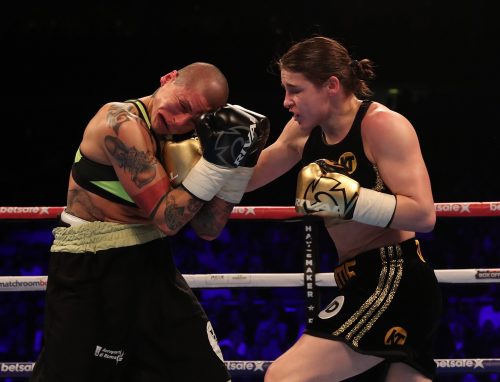Women, Boxing & Prejudice
Photo: Lawrence Lustig: Matchroom
Colossal changes have occurred within women’s combat sports in the last two decades, which have challenged society’s perception of women in boxing and mixed martial arts (MMA) (Mitchell, 2012; Woodward, 2014).
Very little research has been produced on the effects on women in society by their inclusion in boxing. However, women in the boxing world reports from many press publications has been positive, promoting women’s participation in the sport.
Following the London 2012 Olympics, female participation in boxing increased dramatically compared to males, in the UK. The Commonwealth Games in 2014, also had a positive effect on participation for both men and women. Not unusually following such events (Brown, Massey & Porter, 2004) the male participants decreased and fell to levels just above how they were pre-Commonwealth games. However, female participation increased.
This suggests that opportunities for women in the boxing world are improving, compared to previous years.
Nonetheless the number of males still outweighs the number of females involved in the sport. There are obviously gender related issues involved in combat sports.
Females in combat sport confront barriers and negative experiences as a consequence of their gender including; verbal and physical abuse, sexual harassment, lack of opportunity and lack of financial investment (Halbert, 1997; Lafferty and Mckay, 2004; Paradis 2012).
In Australia, Lafferty and McKay (2004) found that females were given less access to sparring opportunities and not taken seriously by coaches.
Comparable concerns were also present in a study in the USA by Paradis (2012) which also showed substantial levels of verbal abuse from male boxers.
The negative psychological implications these issues can have on women may also lead to a reduced retention rate of female boxers (Hurst and Beesly, 2013).
In sports such as boxing and MMA, these disputes arise because they do not fit in with the traditional expectations of femininity (Connell and Messerschmidt, 2005).
Women are expected to be beautiful, graceful, submissive, and elfin with negligible belligerent tendencies.
There are conflicting values in female boxing which reward the winner. Cultural femininity is challenged when customs are opposed.
Nicola Adams won gold at the 2012 Olympics, which had a progressive effect on challenging the dominance of males in boxing, but she received a series of negative criticisms on her appearance and legitimacy as a boxer (Phillips, 2012).
Alfermann and Stambulova (2007) have stressed, an athletic career depends on a subtle balance of resources and overcoming barriers.
Will current prejudices in boxing (Fulton, 2011) continue to hinder the progress for females in boxing in the UK?
To prevent such pessimism, should not their rewards be the same as males, as in other sports, e.g., tennis?
It is critical that we assess the subjective and collective experiences of females who progress from amateur status to professional at an elite level, and the entire sporting atmosphere of boxing.
Ultimately, while the modern woman might utilise boxing to categorise a fundamental discontinuation from past eras, or a reinvention of herself, she might also use it to stage the violence and trauma of the era, aware of its limits and vulnerabilities (Gammel, 2015).
REFERENCES
Alfermann, D., & Stambulova, N. (2007). Career transitions and career termination. In G. Tenenbaum and R. C. Eklund (Eds.), Handbook of sport psychology (3rd ed., pp. 712-736). New York, NY: Wiley.
Brown, A., Massey, J. and Porter, C. (2004). The Sports Development Impact of the 2002 Commonwealth Games: Post Games Report. UK Sport.
Connell, R., Messerschmidt, J. (2005) Hegemonic Masculinity. Rethinking the concept Gender and Society. 19: 229–247.
Fulton, J. (2011) ‘What’s your worth?’ The Development of Capital in British Boxing. European Journal for Sport and Society. 8: 193–218.
Gammel I. (2015). Lacing Up the Gloves. Women, Boxing and Modernity. The Journal of the Social History Society. 9: 369-390.
Halbert, C. (1997) Tough Enough And Woman Enough: Stereotypes, discrimination, and impression management among women professional Boxers. Journal of Sport & Social Issues. 21: 7–36.
Hurst, R. J., Beesley, D. (2013) Perceived sexism, self-silencing, and psychological distress in college women. Sex Roles. 68: 311–320.
Lafferty Y., McKay J. (2004). “Suffragettes in Satin Shorts”? Gender and Competitive Boxing. Qualitative Sociology. 27: 249-276.
Paradis, E. (2012) Boxers, briefs or Bras? Bodies, gender and change in the boxing gym. Body & Society. 18: 82–109.
Phillips, F. (2012) Am I the only person unhappy about women boxing? http://www.catholicherald.co.uk/commentandblogs/2012/08/27/am-i-the-last-person-opposed-to-women-boxing/ [Accessed 25.04.2017].
Mitchell, K. (2012) Nicola Adams wins historic first women’s Olympic boxing gold. http://www.theguardian.com/sport/2012/aug/09/nicola-adams-olympic-boxing-gold [Accessed 25.04.2017].
Woodward, K. (2014). Legacies of 2012: putting women’s boxing into discourse. Contemporary Social Science, 9: 242–252.

